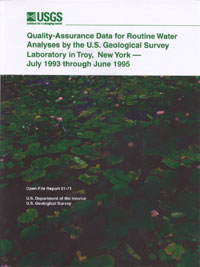 Quality-Assurance Data for Routine Water Analyses by the U.S. Geological Survey Laboratory in Troy, New York--July 1993 through June 1995
Quality-Assurance Data for Routine Water Analyses by the U.S. Geological Survey Laboratory in Troy, New York--July 1993 through June 1995
by Tricia A. Lincoln, Debra A. Horan-Ross, Michael R. McHale, and Gregory B. Lawrence
U.S. GEOLOGICAL SURVEY
Open-File Report 01-071
ABSTRACT
A laboratory for analysis
of low-ionic strength
water has been developed at the U.S.
Geological Survey (USGS) office in Troy, N.Y., to
analyze samples collected by USGS projects in
the Northeast. The laboratory's quality-assurance
program is based on internal and interlaboratory
quality-assurance samples and quality-control
procedures developed to ensure proper sample
collection, processing, and analysis. The
quality-assurance/quality-control data are stored in the
laboratory's SAS data-management system,
which provides efficient review, compilation, and
plotting of quality-assurance/quality-control data.
This report presents and discusses samples
analyzed from July 1993 through June 1995.
Quality-control results for 18 analytical
procedures were evaluated for bias and precision.
Control charts show that data from seven of the
analytical procedures were biased throughout the
analysis period for either high-concentration or
low-concentration samples but were within
control limits; these procedures were: acid-neutralizing
capacity, dissolved inorganic carbon,
dissolved organic carbon (soil expulsions),
chloride, magnesium, nitrate (colorimetric
method), and pH. Three of the analytical
procedures were occasionally biased but were
within control limits; they were: calcium (high for
high-concentration samples for May 1995),
dissolved organic carbon (high for highconcentration
samples from January through
September 1994), and fluoride (high in samples
for April and June 1994). No quality-control
sample has been developed for the organic
monomeric aluminum procedure.
Results from the filter-blank and analytical-blank
analyses indicate that all analytical
procedures in which blanks were run were within
control limits, although values for a few blanks
were outside the control limits. Blanks were not
analyzed for acid-neutralizing capacity, dissolved
inorganic carbon, fluoride, nitrate (colorimetric
method), or pH.
Sampling and analysis precision are evaluated
herein in terms of the coefficient of variation
obtained for triplicate samples in 14 of the 18
procedures. Data-quality objectives were met by
more than 90 percent of the samples analyzed in
all procedures except total monomeric aluminum
(85 percent of samples met objectives), total
aluminum (70 percent of samples met objectives),
and dissolved organic carbon (85 percent of
samples met objectives). Triplicate samples were
not analyzed for ammonium, fluoride, dissolved
inorganic carbon, or nitrate (colorimetric method).
Results of the USGS interlaboratory Standard
Reference Sample Program indicated high data
quality with a median result of 3.6 of a possible
4.0. Environment Canada's LRTAP
interlaboratory study results indicated that more
than 85 percent of the samples met data-quality
objectives in 6 of the 12 analyses; exceptions
were calcium, dissolved organic carbon, chloride,
pH, potassium, and sodium. Data-quality
objectives were not met for calcium samples in
one LRTAP study, but 94 percent of samples
analyzed were within control limits for the
remaining studies. Data-quality objectives were
not met by 35 percent of samples analyzed for
dissolved organic carbon, but 94 percent of
sample values were within 20 percent of the most
probable value. Data-quality objectives were not
met for 30 percent of samples analyzed for
chloride, but 90 percent of sample values were
within 20 percent of the most probable value.
Measurements of samples with a pH above 6.0
were biased high in 54 percent of the samples,
although 85 percent of the samples met data-quality
objectives for pH measurements below
6.0. Data-quality objectives for potassium and
sodium were not met in one study (only 33
percent of the samples analyzed met the
objectives), although 85 percent of the sample
values were within control limits for the other
studies. Measured sodium values were above the
upper control limit in all studies.
Results from blind reference-sample analyses
indicated that data-quality objectives were met by
more than 80 percent of the chloride, pH,
potassium, and sodium samples. Data-quality
objectives were not met by 35 percent of the
magnesium samples and 45 percent of the sulfate
samples. Data-quality objectives were not met by
calcium samples.
Citation: Lincoln, T.A., Horan-Ross, D.A., McHale, M.R., and Lawrence, G.B., 2001, Quality-Assurance Data for Routine Water Analyses by the U.S. Geological Survey Laboratory in Troy, New York--July 1993 through June 1995:
U.S. Geological Survey Open-File Report 01-071, 25 p.
 [Full Report, Acrobat PDF
([an error occurred while processing this directive])]
[Full Report, Acrobat PDF
([an error occurred while processing this directive])]
[an error occurred while processing this directive]
|
